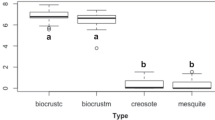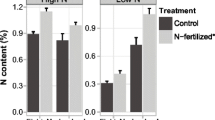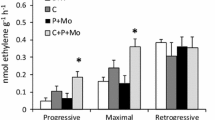Abstract
Periphyton mats are an important component of the Everglades ecosystem. These mats are able to fix atmospheric nitrogen; however little attention has been paid to this function throughout much of the Everglades system. The objective of this study was to characterize and quantify periphyton N2 fixation in the Hole-in-the-Donut (HID) region of the southern Everglades, where farmed marl prairie wetlands have been restored through complete soil removal to reduce nutrient levels. Significantly higher N2 fixation rates (measured acetylene reduction) were found in periphyton of the areas cleared in 2000 and 2003 (3–10 nmol g−1 DW h−1) compared to the reference wetland site (less than 1 nmol g−1 DW h−1). Overall rates were stimulated by light (~2 times the measured dark rates). Areal estimates of fixed N were low compared to other Everglades, ranging from 0.1–0.2 g N m−2 yr−1 in the restored sites to 0.05 g N m−2 yr−1 in the reference area. Stable N isotopic ratios (i.e., δ15 N) ranged from −1.0‰ to 0.2‰ and were correlated with nitrogenase activity and TN:TP ratios. These findings suggest that periphyton nitrogenase activity and δ15 N could serve as indicators of nutrient status and restoration success in these systems.






Similar content being viewed by others
References
Anderson JM (1976) An ignition method for determination of total phosphorus in lake sediments. Water Research 10:329–331
Aranibar JN, Andersonw IC, Ringrosez S, Macko SA (2002) Importance of nitrogen fixation in soil crusts of southern African arid ecosystems: acetylene reduction and stable isotope studies. Journal of Arid Environments 54:345–358
Browder JA, Gleason PJ, Swift DR (1994) Periphyton in the Everglades: spatial variation, environmental correlates, and ecological implications. In: Davis SM, Ogden JC (eds) Everglades: The ecosystem and its restoration. St. Lucie Press, Delray Beach
Cleveland CC, Liptzin D (2007) C:N:P stoichiometry in soil: is there a “Redfield ratio” for the microbial biomass? Biogeochemistry 85:235–252
Craine JM, Jackson RD (2010) Plant nitrogen and phosphorus limitation in 98 North American grassland soils. Plant Soil 334:73–84
Dalrymple GH, Doren RF, O’Hare NK, Norland MR, Armentano TV (2003) Plant colonization after complete and partial removal of disturbed soils for wetland restoration of former agricultural fields in Everglades National Park. Wetlands 23:1015–1029
Davis S, Gaiser E, Loftus W, Huffman A (2005) Southern marl prairies conceptual ecological model. Wetlands 25:821–831
Dodds WK, Smith VH, Lohman K (2002) Nitrogen and phosphorus relationships to benthic algal biomass in temperate streams. Canadian Journal of Fisheries and Aquatic Sciences 59:865–874
Doyle RD, Fisher TR (1994) Nitrogen fixation by periphyton and plankton on the Amazon floodplain at lake Calado. Biogeochemistry 26:41–66
Evans RD, Ehleringer JR (1993) A break in the nitrogen cycle in aridlands? Evidence from δ15N of soils. Oecologia 94:314–317
Fay P (1992) Oxygen relations of nitrogen fixation in cyanobacteria. Microbiological Reviews 56:340–373
Gaiser EE (2009) Periphyton as an indicator of restoration in the Everglades. Ecological Indicators 9(6):S37–S45
Gaiser E, Scinto L, Richards J, Jayachandran K, Childers D, Trexler J, Jones R (2004) Phosphorus in periphyton mats provides best metric for detecting low-level P enrichment in an oligotrophic wetland. Water Research 38:507–516
Gaiser E, Richards J, Trexler J, Jones R, Childers D (2006) Periphyton responses to eutrophication in the Florida Everglades: cross-system patterns of structural and compositional change. Limnology and Oceanography 51:617–630
Gaiser EE, McCormick PV, Hagerthey SE, Gottlieb AD (2011) Landscape patterns of periphyton in the Florida Everglades. Critical Reviews in Environmental Science and Technology 41:92–120
Goericke RJ, Montoya P, Fry B (1994) Physiology of isotopic fractionation in algae and cyanobacteria. In: Lajtha K, Michener H (eds) Stable isotopes in ecology and environmental science. Blackwell Scientific publications, New York
Gottlieb A, Richards J, Gaiser E (2005) Effects of desiccation duration on the community structure and nutrient retention of short and long-hydroperiod Everglades periphyton mats. Aquatic Botany 82:99–112
Gu B, Alexander V (1993) Estimation of N2-fixation based on differences in the natural abundance of 15N among freshwater N2-fixing and non-N2-fixing algae. Oecologia 96:43–48
Handley LL, Raven JA (1992) The use of natural abundance of nitrogen isotopes in plant physiology and ecology. Plant and Cell Environment 15:965–985
Hagerthey SE, Bellinger BJ, Wheeler K, Gantar M, Gaiser E (2011) Everglades periphyton: a biogeochemical perspective. Critical Reviews in Environmental Science and Technology 41:309–343
Hecky RE, Kilham P (1988) Nutrient limitation of phytoplankton in freshwater and marine environments: a review of recent evidence on the effects of enrichment. Limnology and Oceanography 33:796–822
Howarth (1990) Nitrogen-fixing cyanobacteria in the plankton of lakes and estuaries: a reply to the comment by Smith. Limnology and Oceanography 35:1859–1863
Howarth RW, Marino R, Lane J, Cole JJ (1988a) Nitrogen fixation in freshwater, estuarine, and marine ecosystems. 1. Rates and importance. Limnology and Oceanography 33:669–687
Howarth RW, Marino R, Cole JJ (1988b) Nitrogen fixation in freshwater, estuarine, and marine ecosystems. 2. Biogeochemical controls. Limnology and Oceanography 33:688–701
Inglett PW, Reddy KR (2006) Investigating the use of macrophyte stable C and N isotopic ratios as indicators of wetland eutrophication: patterns in the P-affected Everglades. Limnology and Oceanography 51:2380–2387
Inglett PW, Reddy KR, McCormick PV (2004) Periphyton chemistry and nitrogenase activity in a northern Everglades ecosystem. Biogeochemistry 67:213–233
Inglett PW, D’Angelo EM, Reddy KR, McCormick PV, Hagerthey SE (2009) Periphyton nitrogenase activity as an indicator of wetland eutrophication: spatial patterns and response to phosphorus dosing in a northern Everglades ecosystem. Wetlands Ecology and Management 17:131–144
Inglett PW, Rivera-Monroy VH, Wozniak JR (2011a) Biogeochemistry of nitrogen across the Everglades landscape. Critical Reviews in Environmental Science and Technology 41:187–216
Inglett KS, Inglett PW, Reddy KR (2011b) Biogeochemical succession in early development of calcareous wetland soils, in review
Iwaniec D, Childers DL, Rondeau D, Madden CJ, Saunders CJ (2006) Effects of hydrologic and water quality drivers on periphyton dynamics in the southern Everglades. Hydrobiologia 569:223–235
Kline TC, Lewin RA (1999) Natural 15N/14N abundance as evidence for N2 fixation by Prochloron (Prochlorophyta) endosimbiotic with didemnid ascidians. Symbiosis 26:193–198
McCormick PV (2011) Soil and periphyton indicators of anthropogenic water-quality changes in a rainfall-driven wetland. Wetlands Ecology and Management 19:19–34
McCormick PV, O’Dell MB (1996) Quantifying periphyton responses to phosphorus in the Florida Everglades: a synoptic-experimental approach. Journal of the North American Benthological Society 151:450–468
McCormick PV, Stevenson RJ (1998) Periphyton as a tool for ecological assessment and management in the Florida Everglades. Journal of Phycology 34:726–733
McCormick PV, Rawlik PS, Lurding K, Smith EP, Sklar FH (1996) Periphyton-water quality relationships along a nutrient gradient in the northern Florida Everglades. Journal of the North American Benthological Society 15:433–449
McCormick PV, Shuford RBE III, Backus JB, Kennedy WC (1998) Spatial and seasonal patterns of periphyton biomass and productivity in the northern Everglades, Florida, USA. Hydrobiologia 362:185–208
Nadelhoffer KJ, Fry B (1994) Nitrogen isotope studies in forest ecosystems. In: Lajtha K, Michener H (eds) Stable isotopes in ecology and environmental science. Blackwell Scientific publications, New York
Pinckney JL, Long RA, Paerl HW (2011) Structural and functional responses of microbial mats to reductions in nutrient and salinity stressors in a Bahamian hypersaline lagoon. Aquatic Microbial Ecology 62:289–298
Redfield AC (1973) On the proportions of organic derivations in sea water and their relation to the composition of plankton. In: Daniel RJ (ed) James Johnstone Memorial Volume. University Press of Liverpool, pp. 177–192, 1934
Rejmánková E (2001) Effect of experimental phosphorus enrichment on oligotrophic tropical marshes in Belize, Central America. Plant and Soil 236:33–53
Rejmánková E, Komárková J (2000) A function of cyanobacterial mats in phosphorus-limited tropical wetlands. Hydrobiologia 431:135–153
Rejmánková E, Komárková J (2005) Response of cyanobacterial mats to nutrient and salinity changes. Aquatic Botany 83:87–107
Rejmánková E, Komárková J, Rejmánek M (2004) δ15N as an indicator of N2 fixation by cyanobacterial mats in tropical marshes. Biogeochemistry 67:353–368
Scott JT, Doyle RD, Filstrup CT (2005) Periphyton nutrient limitation and nitrogen fixation potential along a wetland nutrient-depletion gradient. Wetlands 25:439–448
Scott JT, Doyle RD, Back JA, Dworkin SI (2007) The role of N2 fixation in alleviating N limitation in wetland metaphyton: enzymatic, isotopic, and elemental evidence. Biogeochemistry 84:207–218
Sharma K, Inglett PW, Reddy KR, Ogram AV (2005) Microscopic examination of photoautotrophic and phosphatase-producing organisms in phosphorus-limited Everglades periphyton mats. Limnology and Oceanography 50:2057–2062
Smith VH (1983) Low nitrogen to phosphorous ratios favor dominance by blue-green algae in lake phytoplankton. Science 221:669–671
Smith VH (1990) Nitrogen, phosphorus, and nitrogen fixation in lacustrine and estuarine ecosystems. Limnology and Oceanography 35:1852–1859
Smith CS, Serra L, Li YC, Inglett PW, Inglett K (2011) Restoration of disturbed lands: the Hole-in-the-Donut restoration in the Everglades. Critical Reviews in Environmental Science and Technology 41:723–739
Thomas S, Gaiser E, Gantar M, Scinto L (2006) Quantifying the responses of calcareous periphyton crusts to rehydration: a microcosm study (Florida Everglades). Aquatic Botany 84:317–323
Thomas S, Gaiser EE, Gantar M, Pinowska A, Scinto LJ, Jones RD (2002) Growth of calcareous epilithic mats in the margin of natural and polluted hydrosystems: phosphorus removal implications in the C-111 Basin, Florida Everglades, USA. Lake and Reservoir Management 18:324–330
Vargas R, Novelo E (2007) Seasonal changes in periphyton nitrogen fixation in a protected tropical wetland. Biology and Fertility of Soils 43:367–372
Vis C, Hudon C, Cattaneo A, Pinel-Alloul B (1998) Periphyton as an indicator of water quality in the St Lawrence River (Québec, Canada). Environmental Pollution 101:13–24
Wright AL, Wang Y, Reddy KR (2008) Loss-on-ignition method to assess soil organic carbon in calcareous Everglades Wetlands. Communications in Soil Science and Plant Analysis 39:3074–3083
Acknowledgments
We thank the following for their help in this work. Field support was provided by L. Serra, C. Fisher and A. S. McKinley (US National Park Service), and C. Medvedeff, B. Hogue, and K. Inglett (University of Florida). Laboratory assistance was provided by Yu Wang and Gavin Wilson of the Wetland Biogeochemistry Laboratory (University of Florida). This research was funded by grant J5297-07-0276 from the US National Park Service and the Everglades National Park, Hole-in-the-Donut Wetland Restoration Project.
Author information
Authors and Affiliations
Corresponding author
Rights and permissions
About this article
Cite this article
Liao, X., Inglett, P.W. Biological Nitrogen Fixation in Periphyton of Native and Restored Everglades Marl Prairies. Wetlands 32, 137–148 (2012). https://doi.org/10.1007/s13157-011-0258-4
Received:
Accepted:
Published:
Issue Date:
DOI: https://doi.org/10.1007/s13157-011-0258-4




